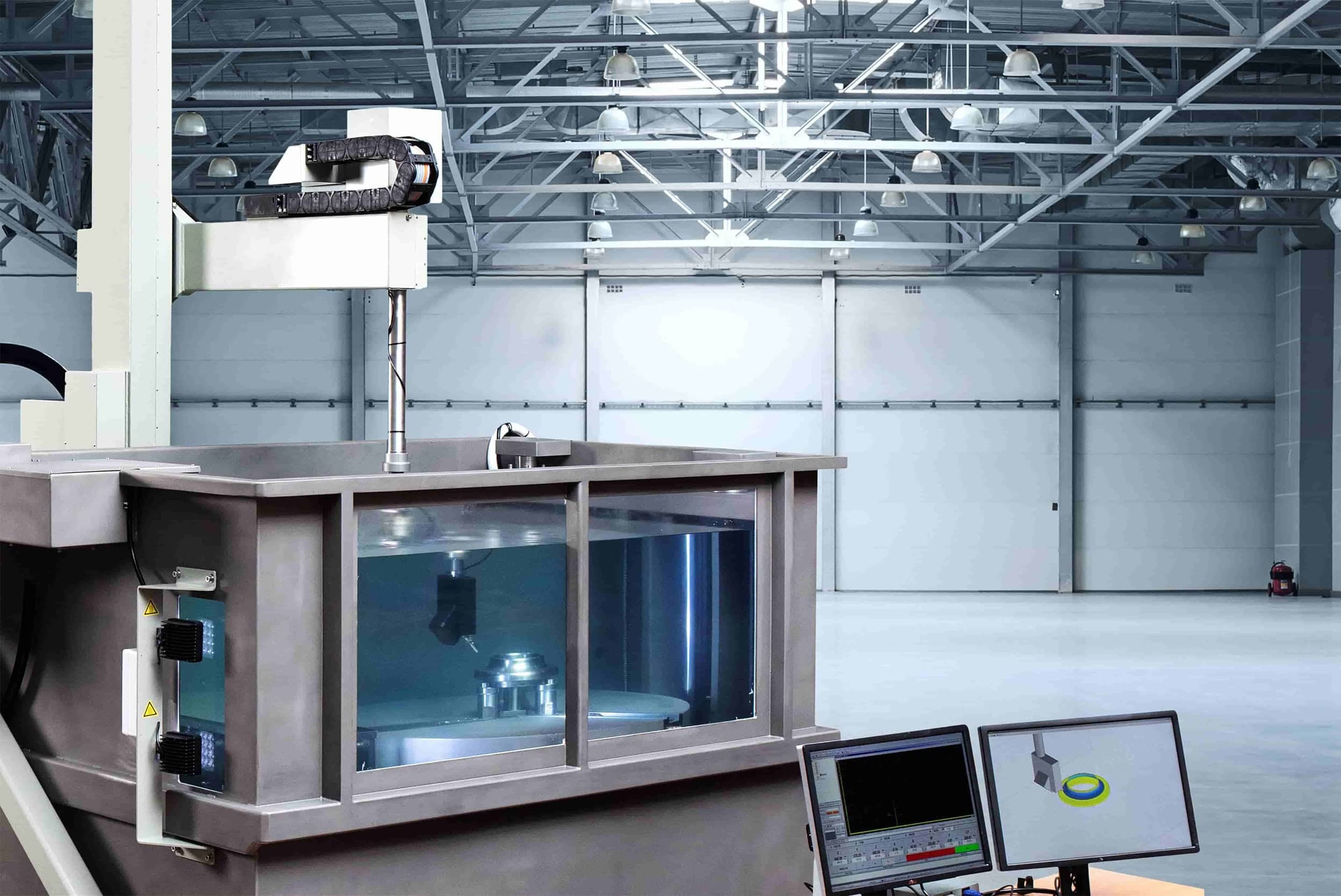ScanMaster Ultrasonic Immersion Testing Systems

ScanMaster provides state-of-the-art ultrasonic immersion testing systems designed for high throughput and multi-shift operation in industrial and laboratory environments. Our fully integrated systems offer various scan configurations and utilize both conventional and phased-array ultrasonic technologies to support a variety of applications – from inspecting engine discs and high-pressure turbine blades to testing bars, shafts, billets, and plates.
ScanMaster’s Automated Ultrasonic Testing (AUT) systems are trusted by all leading
ScanMaster is approved by many manufacturers for use in manufacturing facilities and aerospace maintenance, repair and overhaul organisations.
All ScanMaster immersion systems feature high-precision, multi-axis scanning frames for the inspection of complex parts and include a multi-channel ultrasonic device recognised for its exceptional performance. Combined with a comprehensive range of software modules, this versatile system series offers customers the best value for money solutions.
UT of rolling bearings & bearing rings
UT of engine discs
Ultrasonic testing of engine discs with immersion technology
As the exclusive trading partner for Germany and Austria, we work closely with ScanMaster Ultrasonic Testing Solutions in the field of ultrasonic immersion testing. This strategic partnership enables our customers to benefit not only from an extended range of innovative ultrasonic testing solutions, but also from our combined expertise and first-class support and service.
Together, we plan to develop new solutions and services to optimise the quality, efficiency and safety of ultrasonic testing specifically in aerospace and lightweight construction as well as the testing of high-tech composites.

Ultrasonic testing of turbine discs
Ultrasonic immersion testing of complex geometries
The disc, also known as the turbine disc, is an essential component of an engine. The disc plays a central role in converting the energy generated by combustion into mechanical work that drives the aircraft engine. Its design and functionality are critical to the performance and safety of the engine.
This specialised application requires careful and precise testing to ensure that turbines in the aviation industry meet the highest standards.

Powerful CSI software
Ultrasonic testing of complex 3D components with immersion technology
- Offline programming through CAD import
- Comprehensive analysis toolkit for A, B and C scans
- Advanced algorithm for automatic evaluation (1000 gates)
- Creation of comprehensive test reports
- High-resolution, gimbal-mounted probe manipulator
- Protective electromechanical trigger mechanism
- Automation to increase efficiency and reduce errors
- Specialised toolkit for engine coil inspection
Optional modules:
- Continuous movement or motorised two-position lifting device
- Motorised chuck
- Application-adapted multiple transducer probe holder
- Interface for industrial robots for fully automated inspection
Image source: ScanMaster
Ultrasonic bearing testing: ensuring reliability and performance
UT of rolling bearings & bearing rings
Ultrasonic bearing testing: ensuring reliability and performance
Ultrasonic inspection plays a vital role in ensuring the reliability and performance of bearings, which are an important component in a wide range of machinery and equipment. Together with ScanMaster, we offer inspection systems for the inspection of large rolling bearings using immersion technology.
World's largest immersion testing system for bearing rings from ScanMaster Systems
Features of the ScanMaster test systems for immersion technology testing
- Robust immersion tanks with high-precision mechanics for reliable inspection
- Clamping and centring of the rings – Precise positioning of the bearings
- Fast two-position lifting device (operated via the HMI control panel) for easy loading and unloading of bearings – Efficient loading and unloading of bearings
- Motorised rotary table chucks for automated processes – Automated rotary movements for higher productivity
- Interface for connection to a loading and unloading robot – Integration of robot systems
- Multi-transducer probe holder for increased inspection throughput – Acceleration of the inspection processe
- Fully automated inspection process without operator intervention maximises efficiency and prevents operator errors – Efficient inspection without manual intervention
- Efficient ‘teach-in’ function for programming ball and roller bearings – Simple programming of bearings
- Offline part programming by importing CAD models – Programming flexibility
- A, B and C scan data analysis tool kit, including a tool library for analysing and evaluating scan results – Comprehensive analysis tools for precise evaluations
- 3D visualisation of the warehouse model and scanning robot – Visual representation for better analysis
- Comprehensive inspection reports with standard and customised versions -Detailed inspection reports for accurate documentation
-
Proactive defect detection
Proactive defect detection
Maintenance teams can recognise and rectify potential problems at an early stage to avoid costly downtime.
-
Risk minimisation
Risk minimisation
Hidden faults are detected before they cause serious problems, minimising the risk of equipment failure.
-
Cost efficiency
Cost efficiency
Maintenance costs are reduced as targeted repairs and replacements can be carried out instead of waiting for a breakdown.
What is ultrasonic testing with immersion technology?
Ultrasonic testing with immersion technology (immersion) is a very efficient method for detecting small defects and irregularities in the material with a high probability of detection (POD). This inspection method enables precise dimensioning and improved detection of sub-surface defects (improved NSR – Near Surface Resolution). The test results can easily be found in test reports for components.
In immersion ultrasonic testing, the component is immersed in a test vessel with water as the coupling medium. The ultrasonic probe (transducer) is connected to a transducer manipulator (usually with two axes of rotation), which is part of a Cartesian or angular multi-axis scanner. The ultrasonic probe is then moved along a predefined path over the surface of the component, creating a network of points (pixels) where the ultrasonic data is captured.
The ultrasonic wave generated by the probe penetrates the water and enters the component.
As the ultrasonic wave passes through the component, it is reflected back to the probe by defects, flaws or inclusions in the material. The time taken for the wave to return to the probe (ToF = Time of Flight) and the corresponding amplitude can be recorded at any data point (pixel).
The data acquired during the test can be displayed (and retrieved) as an A-scan (per pixel), B-scan, C-scan and D-scan. These images can be analysed using appropriate image processing tools to provide the required information on the integrity of the component.
Ultrasonic testing with water has several advantages. Firstly, water allows better coupling than contact testing, resulting in better resolution near the surface. In addition, the use of a computer-controlled multi-axis scanner allows better and faster inspection of components with complex geometries.
Any questions?
Actemium Cegelec Centre GmbH
Gutenstetter Street 14a
90449 Nuremberg
Phone: +49 (0) 911 9943-0
E-mail: info.nds@actemium.de
